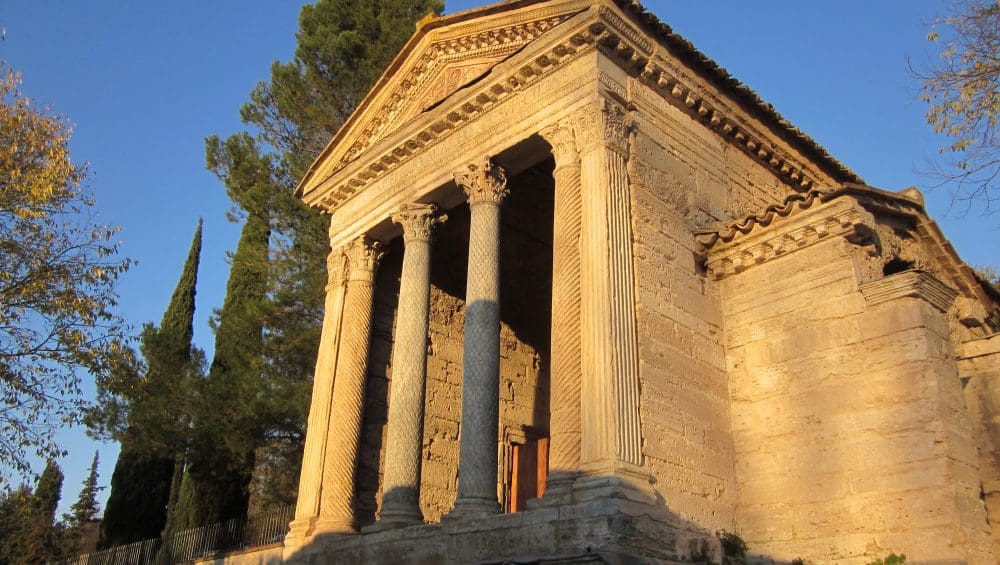The Campello sul Clitunno district is divided into Campello Alto and Campello Basso: the first fortified around the Castle dating back to the 9th-10th century and wanted by the knight from Burgundy, Rovero di Campeaux and the second near the Fonti del Clitunno.
A natural jewel: the Fonti del Clitunno
Crystalline springs at the foot of Mount Brunette, with bright colors that shine with the sun’s rays, creating plays of light, shadows and reflections of the vegetation that is reflected in these waters, sending an image of absolute purity and spirituality.
Already known in Roman times and many poets and writers such as Pliny, Virgil, Propertius, Juvenal, extol their praises in their legacies, speaking of an absolutely suggestive place. The river was revered as a natural element personified by the God Clitunno: its waters so pure as to make those who immersed themselves in it immaculate.
Again the Sources taken up in Corot’s paintings and praised again by Lord Byron in the fourth canto of Child Harold dedicated to Umbria:
“But you, or Clitunno! from your sweetest wave of the brightest crystal that ever sheltered a river nymph, to look inside and bathe her limbs where nothing hid them, you raise your grassy banks along which the milk-white bullock grazes; O thou – purest God of mild waters, and most serene of aspect, and most limpid, indeed thy current was not desecrated by carnage – mirror and pool for Beauty’s youngest daughters”
The very rich vegetation and biodiversity make the Fonti del Clitunno a small paradise among cypress poplars and weeping willows which with their foliage adorn the landscape and frame the waters, are strongly linked to Napoleon: in fact, it is said that they come from the place where the ‘Emperor on Saint Helena. The vegetation on the seabed is also rich such as: wild sedanine, aquatic horsetail and aquatic nasturtium.
Temple of Clitunno
Not far from the Fonti del Clitunno, there is the small but wonderful Tempietto del Clitunno, a UNESCO World Heritage Site since 2011.
Built in the early Christian era (it is assumed between the 5th and 7th centuries) with salvaged elements from the pagan sacellums (from the Latin sacellum, dim. of sacrum “sacred enclosure”) of the god Clitunno, today it is part of the seven jewels of ” The Lombards in Italy. Places of Power”.
On the tympanum it is still possible to see the decorations showing pomegranate and a bunch of grapes: if the first symbolizes fertility, grapes and more particularly wine is the symbol of the Eucharist.
“And on your happy shore a Temple, of minute and delicate structure, still keeps the memory of you on the gentle slope of a hill; beneath it flows your placid current; often leaps forth from it the darting fish with glittering scales, which dwells and plays in your crystalline depth; while perhaps some lost water lily flower floats by where the less deep wave still repeats its bubbling tales”
Lord Byron
In Green painted Green
In addition to the natural wonders, the historical ones and still those linked to Trebbiano Spoletino, the hills of Campello are adorned with green olive trees which are still cultivated today with traditional methods and make Campelli one of the paths of the olive grove.
The olive tree has Etruscan origins and was later spread by the Romans as a luxury item. Pliny the Younger himself had several hectares in Umbria dedicated to the cultivation of olive trees.
What remains of this story is the hope of being able to experience a place absolutely full of beauty accompanied by a glass of Trebbiano Spoletino and a slice of warm bread with local oil and admire, as Lord Byron, Carducci did and Pliny, the marvel of Campello sul Clitunno.



